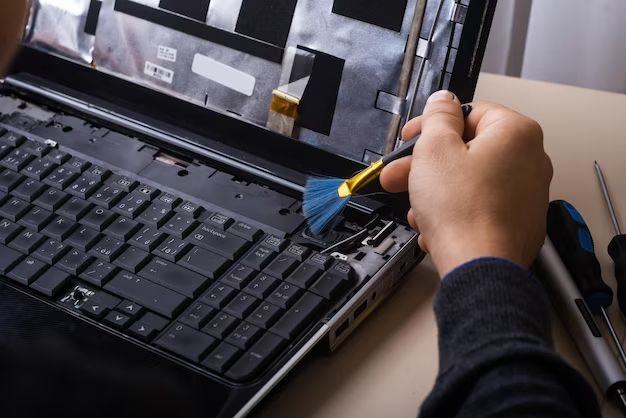Losing files on your laptop due to damage or destruction can be devastating. Important documents, photos, music and other data may seem impossible to retrieve. However, there are several options you can try to recover files from a destroyed laptop. The chances of recovery depend on the extent and type of damage. With the right tools and techniques, you may be able to salvage all or some of your files.
Assess the Damage
The first step is to assess the damage to determine if data recovery is possible. Some questions to consider:
– Is the laptop physically damaged or completely destroyed? Physical damage like a cracked screen or case may not affect the hard drive. Complete destruction makes recovery unlikely.
– Does the laptop turn on? If it powers on even intermittently, the hard drive may be intact. No power could signal damage beyond repair.
– Can you access the BIOS? Navigating to the Basic Input/Output System (BIOS) indicates the motherboard is functioning.
– Are there signs of electrical damage like burn marks? Electrical surges can destroy electronic components and data.
– Is the hard drive making unusual noises? Clicking or beeping could mean physical failure.
Attempt to Boot the Laptop
If the laptop turns on, try booting it up normally to see if you can access the files. Even if the operating system is corrupted, you may be able to boot into safe mode or recovery mode to copy files to an external drive.
If the laptop won’t boot, connecting it to an external monitor may allow you to back up files. You can also remove the hard drive and connect it to another computer with a USB hard drive adapter.
Use Data Recovery Software
If you can’t directly access the files, run data recovery software to scan the drive and extract recoverable data. Software looks for intact sectors of the drive that weren’t damaged.
Some top data recovery programs include:
Recuva
– Free software from Piriform for recovering deleted and lost files
– Allows deep scan of damaged drives
– Supports Windows only
EaseUS Data Recovery Wizard
– Complete data recovery solution with strong RAID recovery
– Can recover from formatted drives and OS crashes
– Free and paid versions available
Stellar Data Recovery
– Recovers data from hard drives, SSDs, SD cards, etc
– Has physical damage repair tools
– Free preview before paying for full recovery
Run read-only scans first to prevent overwriting data. Also recover files to another drive, not the damaged one.
Remove and Test the Hard Drive
If software scans don’t detect files, the drive itself may have physical damage. Removing the hard drive to test externally provides a few other recovery options:
– Use recovery software on another computer
– Try drive repair tools that can fix issues like electrical shorts and motor failure
– Examine the drive platters directly in a clean room environment
– Transplant the platters into an identical working drive
This is a last resort as removing the drive without proper equipment can make physical damage worse. Consult a data recovery specialist first.
Send to a Data Recovery Service
For severe physical damage like burnt, broken, or water-damaged drives, professional data recovery may be your best chance for file retrieval. Specialists have access to advanced tools and clean room facilities to repair drives and recover data.
Common recovery techniques used by pros include:
– Disk imaging – Makes an exact sector-by-sector copy of the drive to work on separately. This prevents tampering with the source.
– Degaussing – Uses magnetic force to repair corrupt or unreadable drive sectors.
– Disk transplant – Removes platters from the damaged drive and installs them in a repaired unit.
– Circuit board swap – Replaces damaged circuit boards with functioning ones from an identical drive.
– Forensics and clean room recovery – Involves dismantling the drive and examining the internal components under a microscope in a dust-free environment.
Professional recovery services can be expensive, with costs ranging from a few hundred to several thousand dollars. But they may recover the data when all else fails. Weigh the importance of your files against the cost.
Prevent Future Data Loss
While the methods above can potentially recover lost files from a destroyed laptop, prevention is the best policy. Always maintain backups of critical files on external drives or cloud storage. Store laptops safely to avoid physical damage. Manage power settings to prevent sudden shutdowns during critical read/write operations.
Following good backup practices means you’ll always have intact copies of important data if your laptop is damaged or destroyed. But if disaster does strike, don’t give up hope. With persistence and the right tools, you may be able to get key files back.
Conclusion
Recovering lost files from a destroyed laptop presents many challenges, but is possible in some cases. Assessing the damage and attempting recovery techniques like booting the laptop, using data recovery software, sending it to a professional service, or directly examining the hard drive can restore data when hardware fails. While outcomes depend on the severity of the damage, combining multiple recovery methods gives the best chance to salvage important documents, photos, and other digital assets. Above all, consistently backing up critical files provides the ultimate protection. With reliable backups, you can confidently recover from even the most catastrophic laptop failure.

